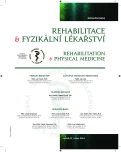The Influence of Morphological Variables of the Foot on Kinematics of the Gait
Authors:
H. Hájková 1; Z. Svoboda 2; M. Přidalová 2
Authors‘ workplace:
NZZ REHASPRING, Čelákovice, vedoucí PhDr. I. Palaščáková Špringrová, Ph. D.
1; Katedra přírodních věd v kinantropologii, FTK UP, Olomouc, vedoucí prof. RNDr. M. Janura, Dr.
2
Published in:
Rehabil. fyz. Lék., 21, 2014, No. 1, pp. 11-15.
Category:
Original Papers
Overview
The purpose of the study is to investigate the influence of selected indexes and angle parameters of the foot on kinematic changes of the ankle, knee, hip and pelvis during the gait cycle. The research group consisted of 27 male with an average age of 24.1. Selected indexes and foot angular parameters were obtained by processing four imprints of the bare foot in each of the subject. The Vicon MX system was used for kinematic analysis of the gait. We have noted the influence of foot indexes on kinematic parameters in all joints of the lower extremity. Statistically significant differences were found in maximum flexion and extension of the hip in the sagittal plane during the gait cycle. We found that the foot angle and heel angle do not affect the kinematic parameters of the lower extremity and pelvis. Big toe angle affects the peak of ankle plantar flexion during loading response.
Keywords:
foot, plantography, gait cycle, three-dimensional kinematic analysis
Sources
1. BENDOVÁ, P., ŠPRINGROVÁ, I., TICHÝ, M.: Sledování změn rozložení tlaků na ploskách nohou ve vzpřímeném stoji v souvislosti s tvarovými změnami pánve. Rehabilitace a fyzikální lékařství, 2003, č. 4, s. 14-16.
2. BÍNOVÁ, A., ŠPRINGROVÁ, I.: Nové aspekty v metodě Roswithy Brunkow sledováním aktivity vybraných svalů pomocí povrchové EMG. Rehabilitace a fyzikální lékařství, 2008, č. 2, s.74-81.
3. DINSDALE, N.: How abnormal foot motion can be a major contributor to lower back and pelvic problems. SportEX dynamics, 2009, č. 19, s. 11-14.
4. DUVAL, K., LAM, T., SANDERSON, D.: The mechanical relationship between the rearfoot, pelvis and low-back. Gait and Posture, 2010, č. 4, s. 637-640.
5. Guiotto, A., Sawacha, Z., Guarneri, G., Cristoferi, G., Avogaro, A., Cobelli, C.: The role of foot morphology on foot function in diabetic subjects with or without neuropathy. Gait and Posture, 37, 2013, č. 4, s. 603-610.
6. JANURA, M., CABELL, L., SVOBODA, Z., KOZAKOVA, J., GREGORKOVA, A.: Kinematic snalysis of gait in patients with juvenile hallux valgus deformity. Journal of Biomechanical Science and Engineering, 2008, č. 3, s. 390-398.
7. LEVINGER, P., MURLEY, G. S., BARTON, CH. J., COTCHETT, M. P., McSWEENEY, S. R., MENZE, H. B.: A comparison of foot kinematics in people with normal - and flat-arched feet using the Oxford foot model. Gait and Posture, 2010, č. 32, s. 519-523.
8. LEWIT, K., LEPŠÍKOVÁ, M.: Chodidlo - významná část stabilizačního systému. Rehabilitace a fyzikální lékařství, 2008, č. 3, s. 99-104.
9. PALAŠČÁKOVÁ ŠPRINGROVÁ, I.: Akrální koaktivační terapie. Ingrid Palaščáková Špringrová, REHASPRING, 2011.
10. PINTO, R. Z. A., SOUZA, T. R., TREDE, R. G., KIRKWOOD, R. N., FIGUEIREDO, E. M., FONSECA, S. T.: Bilateral and unilateral increases in calcaneal eversion affect pelvic alignment in standing position. Manual Therapy, 2008, 13, s. 513-519.
11. ROSE, J., GAMBLE, J. G.: Human walking. Philadelphia: Williams & Wilkins, 2006.
12. SOUZA, T. R., PINTO, R. Z., TREDE, R. G., KIRKWOOD, R. N., FONSECA, S. T.: Temporal couplings between rearfoot-shank komplex and hip joint during walking. Clinical Biomechanics, 2010, č. 25, s. 745-748.
13. TOPPISCHOVÁ, M., ŠNOPLOVÁ, A.: Funkce nohy. Bolest, 2008, č. 2, s. 109-111.
14. VAŘEKA, I., VAŘEKOVÁ, R.: Kineziologie nohy. Olomouc: Univerzita Palackého, 2009.
15. WILKEN, J., RAO, S., SALTZMAN, C., YACK, H. J.: The effect of arch height on kinematic coupling during walking. Clin. Biomech., 26, 2011, 26, s. 318-323.
Labels
Physiotherapist, university degree Rehabilitation Sports medicineArticle was published in
Rehabilitation & Physical Medicine

2014 Issue 1
- Hope Awakens with Early Diagnosis of Parkinson's Disease Based on Skin Odor
- Deep stimulation of the globus pallidus improved clinical symptoms in a patient with refractory parkinsonism and genetic mutation
Most read in this issue
- Respiratory Complications in Patients after Spinal Cord Injury and their Management at the Spinal Cord Unit in University Hospital Motol
- Qualitative Evaluation and Testing in Patients after Lower Extremity Amputation
- A Study in Typical Changes of Peripheral Circulation during Application of Vacuum-Compression Therapy
- The Influence of Morphological Variables of the Foot on Kinematics of the Gait
